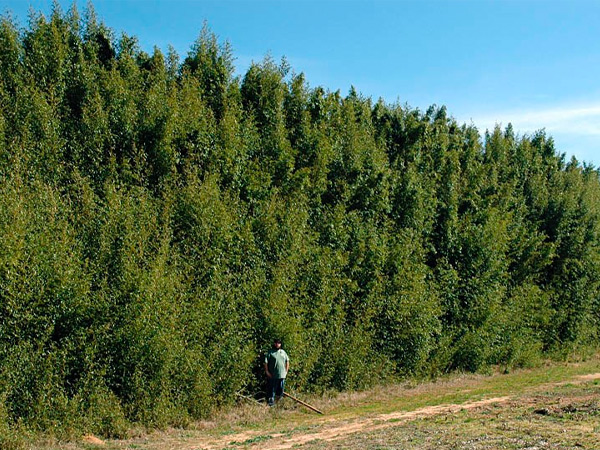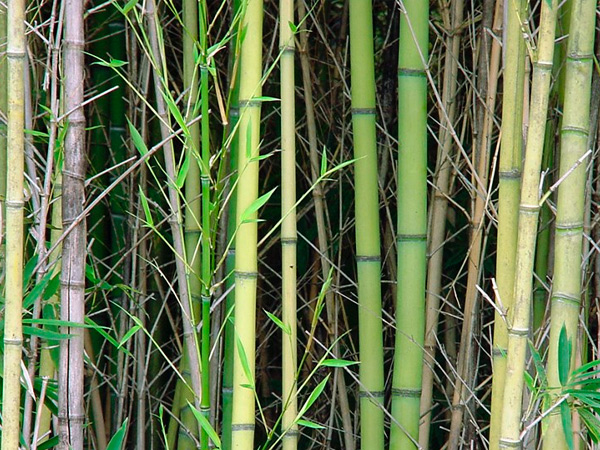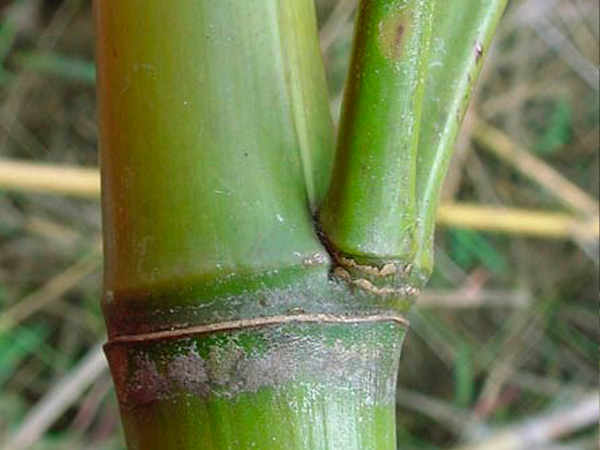Weeds
Golden Bamboo – Phyllostachys aurea
P. aurea is a highly invasive running bamboo native to Southeast China but is now widespread globally and especially problematic in Australia and North America. This woody, rhizomatous perennial grass rapidly forms a dense monoculture, suffocating other native plants and altering the entire ecosystem. As well as having detrimental effects on the environment this bamboo may also damage property and pose as a potential health threat from its harbouring of a fungus responsible for the Histoplasmosis disease. Invasive bamboos are among the fastest growing plants on Earth and one infestation of P. aurea can spread as far as 9.3 miles. The spread is rapid in all directions, increasing each successive year (Gucker, 2009; Rickel, 2012).
It is listed invasive in Australia and Hawaii, and has naturalized or is listed invasive in 273 counties in the USA, including the mid-Atlantic region of the USA, Pennsylvania, Maryland, Virginia, West Virginia, and Georgia. It is reported to be fully naturalized in New Zealand, with infestations forming dense stands, and some invading national parks (Edgar and Connor, 2000; USDA-APHIS, 2012). It has been recorded as High Risk in several Weed Risk Assessments (USDA-APHIS, 2012; NYPRISM, 2013; PIER, 2016) and following New York State Department of Environmental Conservation listing of the species as invasive it has banned all future sales of P. aurea (New York State DEC, 2014).
Profile
Habitat
Infestations occur in undisturbed habitats including along stream edges and riparian corridors (Smith and Mack, 2012). It thrives in full sun, but also tolerates shade, spreading into forests. P. aurea spreads more rapidly in moist soils (USDA-APHIS, 2012).
Continual thick leaf litter within the stand of bamboo along with the dense shade in the bamboo stand prohibits the growth of other species of plants. It is also possible that P. aurea has allelopathic effects (USDA-APHIS, 2012).
Longevity
P. aurea is long lived. Documentation and field work have shown the infestation increases over time to cover acres (EDDMapS, 2016). A single clump of golden bamboo can produce up to 9.3 miles of stems in its lifetime, all interconnected as one organism (Gucker, 2009).
How does it spread?
Natural Dispersal
Cases of spread by water have been documented in Connecticut (Bugwood Presentations, 2014) and there is the potential for rhizome fragments to be washed downstream along riparian corridors (USDA-APHIS, 2012).
Although spreading by seed is unlikely as flowers and seeds are rarely produced it cannot be ruled out completely (USDA-APHIS, 2012).
Accidental Introduction
The spread of P. aurea along roadsides by plows moving rhizomes has been documented. Observation has shown loose rhizome fragments and rhizomes growing up along roadsides where plows could potentially transport the rhizome spreading the bamboo (USDA-APHIS, 2012).
Improper disposal of the rhizomes is common, causing new bamboo infestations to start. Spread can occur from improper dumping of yard waste into natural areas (USDA-APHIS, 2012).
Intentional Introduction
P. aurea has been widely introduced as an ornamental in both temperate and tropical areas of the world (Gucker, 2009). P. aurea has also been introduced for making fishing poles, walking sticks, umbrella and fan handles and pipe stems (McClure, 1957).
What does it look like?
P. aurea is a woody, rhizomatous perennial grass, which grows to form a dense bamboo forest. The main stem is called a culm. The culm is made up of jointed segments. The rings are called nodes. The sections between the nodes or rings are called internodes.
Golden bamboo has distinct swollen internodes, bunched up together at the bottom of some random canes. This unique trait is useful for certainty in the ID of golden bamboo (McClure, 1957). Most canes will have uniformly spaced sections (internodes) as the compressed internode trait only occurs on some canes. Golden bamboo has a slight cupped flare where the sections meet at the nodes (rings). In Japan, the compressed swollen internodes are referred to as deformed stems, and thought to be a reason for the cultivation of the species P. aurea, due to the curiosity of the deformed swollen internodes.
A pure planting of P. aurea can be identified with ease and certainty by the culms. Stems and branches are green when plants are young but turn golden yellow with age. Branches occur in uneven pairs with a groove called a sulcus (Arnold Arboretum, 1946; Gucker, 2009). They can grow to a maximum height of 11.8 m tall and are tolerant of colder temperatures (reportedly up to -20°C) (Arnold Arboretum, 1946; Young and Haun, 1961; Gucker, 2009; EDDMapS, 2016). The diameter of the culms can reach 15 cm but are usually 9 cm or less depending on the age of the stand. Each year the culms will emerge thicker (Gucker, 2009). The length of the rhizomes increases each successive year. In a mature stand the rhizomes may spread 4-7.6 m underground each year (Young and Haun, 1961). Spread is rapid in all directions by the interconnected dense underground rhizome system. A single golden bamboo clump can produce rhizomes spreading 9.3 miles in its lifetime (Gucker, 2009).
P. aurea is an evergreen, even though leaves change each year later in the spring. The old leaves fall off and are gradually replaced with new leaves (McClure, 1957).
Flowers and seeds are rarely produced. Although spreading by seed is unlikely, it cannot be ruled out completely (USDA-APHIS, 2012).
Control
Herbicide recommended. Please refer to your local bush regeneration leader for more information.




